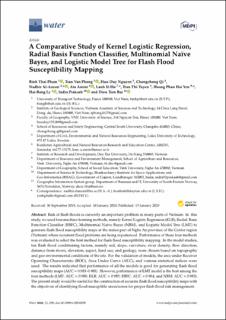| dc.contributor.author | Pham, Binh Thai | |
| dc.contributor.author | Phong, Tran Van | |
| dc.contributor.author | Nguyen, Huu Duy | |
| dc.contributor.author | Qi, Chongchong | |
| dc.contributor.author | Al-Ansari, Nadhir | |
| dc.contributor.author | Amini, Ata | |
| dc.contributor.author | Ho, Lanh Si | |
| dc.contributor.author | Tuyen, Tran Thi | |
| dc.contributor.author | Yen, Hoang Phan Hai | |
| dc.contributor.author | Ly, Hai-Bang | |
| dc.contributor.author | Prakash, Indra | |
| dc.contributor.author | Tien Bui, Dieu | |
| dc.date.accessioned | 2021-04-07T12:03:44Z | |
| dc.date.available | 2021-04-07T12:03:44Z | |
| dc.date.created | 2020-01-27T12:47:11Z | |
| dc.date.issued | 2020 | |
| dc.identifier.citation | Pham, B. T., Phong, T. V., Nguyen, H. D., Qi, C., Al-Ansari, N., Amini, A., ... & Tien Bui, D. (2020). A comparative study of kernel logistic regression, radial basis function classifier, multinomial naïve bayes, and logistic model tree for flash flood susceptibility mapping. Water, 12(1). | en_US |
| dc.identifier.issn | 2073-4441 | |
| dc.identifier.uri | https://hdl.handle.net/11250/2736618 | |
| dc.description.abstract | Risk of flash floods is currently an important problem in many parts of Vietnam. In this study, we used four machine-learning methods, namely Kernel Logistic Regression (KLR), Radial Basis Function Classifier (RBFC), Multinomial Naïve Bayes (NBM), and Logistic Model Tree (LMT) to generate flash flood susceptibility maps at the minor part of Nghe An province of the Center region (Vietnam) where recurrent flood problems are being experienced. Performance of these four methods was evaluated to select the best method for flash flood susceptibility mapping. In the model studies, ten flash flood conditioning factors, namely soil, slope, curvature, river density, flow direction, distance from rivers, elevation, aspect, land use, and geology, were chosen based on topography and geo-environmental conditions of the site. For the validation of models, the area under Receiver Operating Characteristic (ROC), Area Under Curve (AUC), and various statistical indices were used. The results indicated that performance of all the models is good for generating flash flood susceptibility maps (AUC = 0.983–0.988). However, performance of LMT model is the best among the four methods (LMT: AUC = 0.988; KLR: AUC = 0.985; RBFC: AUC = 0.984; and NBM: AUC = 0.983). The present study would be useful for the construction of accurate flash flood susceptibility maps with the objectives of identifying flood-susceptible areas/zones for proper flash flood risk management. | en_US |
| dc.language.iso | eng | en_US |
| dc.rights | Navngivelse 4.0 Internasjonal | * |
| dc.rights.uri | http://creativecommons.org/licenses/by/4.0/deed.no | * |
| dc.title | A Comparative Study of Kernel Logistic Regression, Radial Basis Function Classifier, Multinomial Naïve Bayes, and Logistic Model Tree for Flash Flood Susceptibility Mapping | en_US |
| dc.type | Peer reviewed | en_US |
| dc.type | Journal article | en_US |
| dc.description.version | publishedVersion | en_US |
| dc.rights.holder | © The Author(s). | en_US |
| dc.source.volume | 12 | en_US |
| dc.source.journal | Water | en_US |
| dc.source.issue | 1 | en_US |
| dc.identifier.doi | https://doi.org/10.3390/w12010239 | |
| dc.identifier.cristin | 1782943 | |
| dc.source.articlenumber | 239 | en_US |
| cristin.ispublished | true | |
| cristin.fulltext | original | |
| cristin.qualitycode | 1 | |

